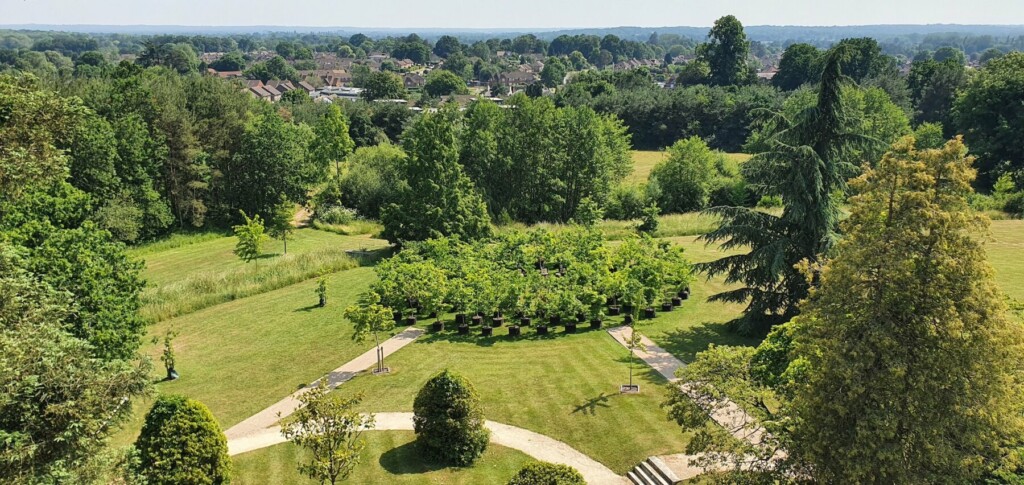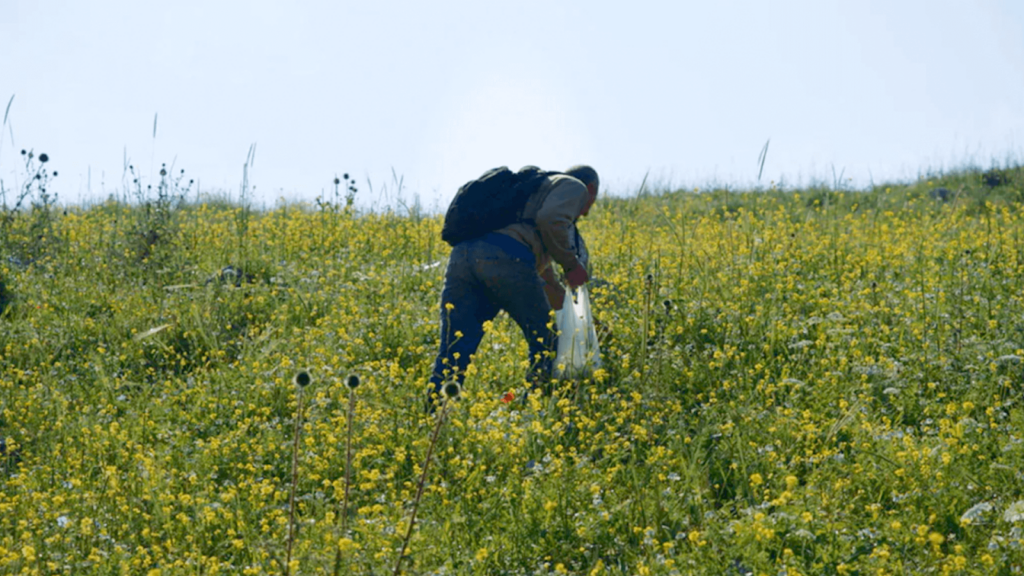Contemporary artists are committed to the long term, to the rhythm of living things’ growth cycles. They create and animate places where principles of collective attention to the soil and flora and to the preservation of the environment germinate. The growing number of local farming initiatives are forging links between ethics, aesthetics, ecology and care. They inspire new ways of creating and living as part of a dynamic of regeneration, in response to the ecological and climatic emergency.
The vitality of this ‘ecological art’, born out of the first alarms about the climatic state of the planet, also testifies to the desire of artists to expand the boundaries of art and to integrate non-human beings into their work.
In the United States, artists are pioneers in soil care and regeneration.
By the time Rachel Carson sounded the alarm in the United States in the 1960s with her book ‘Silent Spring’, artists were already at work. They were reforesting and depolluting the soil and water to revive ecosystems, thus initiating a movement that would later be called ‘ecological art’*. The pioneers Patricia Johanson, Alan Sonfist, Harriet Feigenbaum and Helen and Newton Harrison were followed by Agnes Denes with her famous wheat field planted in 1982 in New York, Wheatfield – A Confrontation (reactivated in 2024 at the heart of the Art Basel fair), and by the artist Mel Chin with Revival Rield in 1991, an in-process work designed to depollute the soil using ‘hyper-accumulating’ plants.
In New York, contemporary artists are keeping this tradition alive and well. Mary Mattingly (see our interview) creates sculptures to purify water, develop self-sufficiency in food production and warn of the effects of global warming.

Water Clock, Mary Mattingly, 2023 © Alexa Hoyer, courtesy of the artist
As part of his long-term project Extinct in the wild, Michael Wang (see our interview) is cultivating an experimental garden 100 kilometres outside New York City, with a selection of plants, algae and lichens that have disappeared from New York City (with the status of ‘extinct in the wild’ according to the IUCN (International Union for Conservation of Nature), and then reintroducing them into the city’s parks. The Swiss Institute is home to some of these ‘rediscovered’ plants. Specialising in the history of plants, it recently revived plants that were present in marshes 8,000 years ago at Shanghai’s Prada Rong Zhai.
New York artist Precious Okoyomon (see our interview) creates gardens of invasive or poisonous plants, questioning the link between these plants and social discrimination.
Places of creation, production and commitment around agriculture
Since the 2010s, artists in Europe, Africa and the Caribbean have been creating places that link art, planting and the preservation of biodiversity. The collaboration between disciplines is fertile, leading to new ways of making art, of investing in the care and cultivation of living things. Through long-term projects, artists are experimenting with new ways of farming and developing solutions for adapting to the climate emergency.
Since 2009, Spanish artist Fernando Garcia Dory has been developing the Inland structure in Spain, dedicated to agricultural, social and cultural production, with the manifesto ‘Art – agriculture – territory’. Since 2012, Estudio Nuboso in Panama has been linking artists, designers, educators and researchers around the nature, culture and science of indigenous communities.
Since 2013, artist Luigi Coppola has been involved with Casa delle Agriculture in Castiglione d’Otranto near Lecce, Italy, as co-activator of a process of participatory agriculture and reclamation of polluted land, involving migrants, students, farmers and activists.
Cooking Sections, an English artist duo, has been running the CLIMAVORE project since 2015, working with biologists, botanists, farmers, chefs and environmental anthropologists to rethink food and imagine seasons of food production and consumption that are adapted to the current ecological and climatic upheavals.
In Africa, Barthélemy Toguo is also one of the pioneers, with Badjoun Station, who created in Cameroon in 2005 (see our article), a long-term artistic, agricultural and political project that opposes agribusiness and defends access to local resources such as coffee or cocoa, the price of which is unaffordable for the local population. The artist takes part in numerous art fairs via a mobile cafeteria, which enables discussions on social justice to take place over a cup of fair-trade coffee or cocoa.
Following in her footsteps, in Ijebu, Nigeria, Yinka Shonibare set up the Guest Artists Space (G. A. S.) Foundation (Nigeria) in 2022, a not-for-profit organisation, a place of residence and research that also includes an organic farm for communities.

The mothership, Yto Barrada, Tanger, Maroc
Recently, still on the African continent, Yto Barrada (who will be representing France at the forthcoming Venice Biennale) opened The Mothership in Tangiers, a garden of dye plants accompanied by an education and research programme. In a country regularly affected by drought, this site provides an opportunity to experiment with solutions for adapting to global warming, as well as traditional methods for conserving and preserving water, soil and land.
Artists planting trees and forests
Artists from all over the world are involved in tree-planting and forestry. In Brazil, partners Sebastiao Salgado and Lélia Deluiz Wanick have set up the Instituto Terra, an organisation whose aim is to breathe new life into Brazil’s Atlantic forest. In France, artist Fabrice Hyber, appointed in November 2021 as the first ambassador of the ONF-Agir pour la forêt fund, planted a forest thirty years ago in his native Vendée region. Today, it is an example of a diversified forest that is more resilient in the face of global warming.
In England, Ackroyd and Harvey, following on from Joseph Beuys‘ 7000 Oaks – City Forestation project, have set up the Beuys’ Acorns – the Prelude & the Planting project, which involves planting seventeen circles of seven trees in public spaces and cultural venues across the UK.

Beuys-Acorns-02-13.06.23-Woodhatch-Place-©-Ackroyd-Harvey
Many artists also contribute to conservation or reforestation projects. For example, Haley Mellin (see our interview) founded Art into Acres, which aims to preserve primary forests while supporting local communities. The artist Julian Charrière (see our interview) inaugurated the Calls to Action project at Art Basel in June, focusing on a programme to preserve Ecuador’s primary forest.
Brazil’s LABVERDE initiative and UNESCO’s Man and the Biosphere programme enable artists to visit the Amazon rainforest to understand the ecological issues at stake, and to take action to preserve it.
Reconnecting with the living to rediscover conviviality in our cities
Artists are not content only to safeguard the wilderness or to implement agricultural practices in the territories as alternatives to an inegalitarian and ecocidal economic system, but are also urging us to re-establish deep relationships with plants, particularly in urban contexts. They are interested in plants for the history of their uses, their resilience and their social benefits for city dwellers.
Last spring, Chinese artist and ecoqueer Zheng Bo (see our interview) presented BAMBOO AS METHOD 格竹, a participatory site-specific installation in the form of a garden of ten different species of bamboo, at Somerset House in London. Sketches made by visitors on compostable paper fertilised the garden, completing a cycle of creativity and ecology.
 Zheng Bo, BAMBOO A METHOD 格竹 @ Somerset house
Zheng Bo, BAMBOO A METHOD 格竹 @ Somerset house
The Italian duo Caretto & Spagna are leading a long-term project, Soil Practice, which operates as an evolving system that allows squares of plants to sprout in place of slabs or concrete in the heart of urban centres. They are among the artists featured until 23 March in the exhibition Mutual Aid, Art in collaboration with nature at the Castello di Rivoli Museum of Contemporary Art in Turin. In France, the artist Thierry Boutonnier is developing urban tree nurseries as part of workcamps and transitional urban planning, in collaboration with local residents.
The participatory dimension is transformed into a feast during large-scale meals celebrating local agriculture, as in March 2024, when Lucy and Jorge Orta activated their 70 x 7 The Meal system for the Diriyah Biennial in Saudi Arabia: a collective meal for 300 people, organised in collaboration with farmers and botanists, highlighting the local species of Wadi Hanifah.
Geopolitics of seeds: towards a counter-history of agriculture?
The social, ecological and political dimensions of agricultural practices, marked by colonialism and today dominated by multinationals, monoculture and the chemical industry, invite artists to see seeds and plants as witnesses and victims of global inequalities.
Maria Tereza Alves from Brazil and Minerva Cuevas from Mexico have each carried out meticulous historical work on seeds and plant species subjected to colonisation and engaged in global trade.
In her 2022 docu-drama Foragers (original title: Al-Yad Al-Khadra), Palestinian artist Jumana Manna denounces the ban on Palestinians picking akkoub, a cousin of the artichoke or za’atar, a type of thyme, on pain of imprisonment under Israeli law. His eponymously titled exhibition at MoMA PS1 in 2023 was accompanied by installations on ancestral agricultural practices in the Levant.
For his part, Mehdi-Georges Lahlou traces the history of the palm tree, the first monocultured oil plant, through a reading that is both historical and social. His exhibition “À l’ombre des Palmiers”, currently on show at Galerie Papillon in Paris, probes the paradox of this plant, now accused of ravaging forests to produce palm oil.
Artist Annalee Davis has set up her studio in a former dairy farm on the Caribbean island of Barbados, historically operated as a seventeenth-century sugar cane plantation. This colonial heritage has led her to explore the role of plants and living plots as ancestral sites of denial, counter-knowledge, community and healing.
Her latest creations, inspired by Karen Armstrong’s book ‘Sacred Nature: Restoring Our Ancient Bond with the Natural World’, are made from textiles, a medium that today, thanks to vegetable dyeing, makes it possible to bring together local agriculture, history, traditional skills and contemporary creation. Textile art, a popular medium in the contemporary art world and supported by many women artists, reveals what goes on in the soil, in plants and in communities. It helps to prolong a process of regeneration and repair, to which all these artists are contributing.
Pauline Lisowski in collaboration with Alice Audouin
Translated into English by Eliza Morris
Cover: Agnes Denes (1931). Wheatfield, a confrontation, Art Basel, curated by Samuel Leuenberger (2024). Photo: TES
Impact Art News, November-December 2024
Subscribe to Impact Art News (free)


